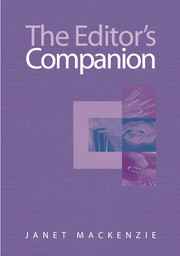Book contents
- Frontmatter
- Contents
- List of illustrations
- Preface
- 1 The editor in context
- 2 The publishing process
- 3 Management and liaison
- 4 Substance and structure
- 5 Language
- 6 Illustrations and tables
- 7 Completeness and consistency
- 8 Proofs
- 9 Editing methods
- 10 Working with documents and files
- 11 Freelance editing
- Appendix: Australian Standards for Editing Practice
- Notes
- Select bibliography
- Index
4 - Substance and structure
Published online by Cambridge University Press: 05 June 2012
- Frontmatter
- Contents
- List of illustrations
- Preface
- 1 The editor in context
- 2 The publishing process
- 3 Management and liaison
- 4 Substance and structure
- 5 Language
- 6 Illustrations and tables
- 7 Completeness and consistency
- 8 Proofs
- 9 Editing methods
- 10 Working with documents and files
- 11 Freelance editing
- Appendix: Australian Standards for Editing Practice
- Notes
- Select bibliography
- Index
Summary
The terms ‘substantive editing’ and ‘structural editing’ are commonly used as synonyms, but shades of meaning can be distinguished. Substantive editing, being concerned with the substance of the book–content and expression as well as structure–is the more comprehensive term. This type of editing requires close consultation with the author and publisher.
Here we examine what substance and structure mean for print and screen publications; methods for substantive editing are described in Chapter 9.
Substance
It is not possible to edit a book unless you can comprehend it. An editor should be able to deal with any publication intended for the educated general reader, but specialist or groundbreaking works might challenge the limits of your understanding. If your knowledge of the topic or your cognitive ability is less than that of the intended reader, say frankly that you're not up to the job and allow the publisher to find an editor with suitable expertise.
The substance of a publication consists of language and illustrations, which are covered in the following two chapters. Here I mention a couple of general points.
Fiction
There is a marked contrast between instrumental writing and creative writing. Generally the reader of non-fiction is a passive recipient, wanting all the information laid out in a logical arrangement with everything fully explained. Fiction readers, by contrast, are active participants: they create meaning in collaboration with the author.
- Type
- Chapter
- Information
- The Editor's Companion , pp. 58 - 74Publisher: Cambridge University PressPrint publication year: 2004



